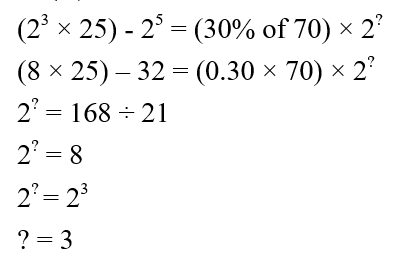Question 1:
Direction: What will come in the place of question mark (?) in the given expression?
निर्देश: दिए गए समीकरण में प्रश्नवाचक चिन्ह (?) के स्थान पर क्या आएगा?
45 × 4 – 360 ÷ 18 – 100 = ?
Question 2:
Direction: What will come in the place of question mark (?) in the given expression?
निर्देश: दिए गए समीकरण में प्रश्नवाचक चिन्ह (?) के स्थान पर क्या आएगा?
25 × 16 + 18 × 14 = ? + 264
Question 3:
Direction: What will come in the place of question mark (?) in the given expression?
निर्देश: दिए गए समीकरण में प्रश्नवाचक चिन्ह (?) के स्थान पर क्या आएगा?
{(81% of 800 + 28 × 4) – 27 × ?} = 11 × 20
Question 4:
Direction: What will come in the place of question mark (?) in the given expression?
निर्देश: दिए गए समीकरण में प्रश्नवाचक चिन्ह (?) के स्थान पर क्या आएगा?
240% of 120 + 512 ÷ 16 × 4 = ? + 108
Question 5:
Direction: What will come in the place of question mark (?) in the given expression?
निर्देश: दिए गए समीकरण में प्रश्नवाचक चिन्ह (?) के स्थान पर क्या आएगा?
15 × 14 + 12 × 14 = ? + 234
Question 6:
Direction: What will come in the place of question mark (?) in the given expression?
निर्देश: दिए गए समीकरण में प्रश्नवाचक चिन्ह (?) के स्थान पर क्या आएगा?

Question 7:
Direction: What will come in the place of question mark (?) in the given expression?
निर्देश: दिए गए समीकरण में प्रश्नवाचक चिन्ह (?) के स्थान पर क्या आएगा?

Question 8:
Direction: What will come in the place of question mark (?) in the given expression?
निर्देश: दिए गए समीकरण में प्रश्नवाचक चिन्ह (?) के स्थान पर क्या आएगा?
24% of 125 + 30% of 700 = ? + 55
Question 9:
Direction: What will come in place of the question mark (?) in the following series?
निर्देश: निम्नलिखित श्रृंखला में प्रश्नवाचक चिन्ह (?) के स्थान पर क्या आएगा?
8, 17, 35, ?, 143, 287
Question 10:
Direction: What will come in the place of question mark (?) in the given expression?
निर्देश: दिए गए समीकरण में प्रश्नवाचक चिन्ह (?) के स्थान पर क्या आएगा?
13, 36, 49, 85, ?, 219, 353


